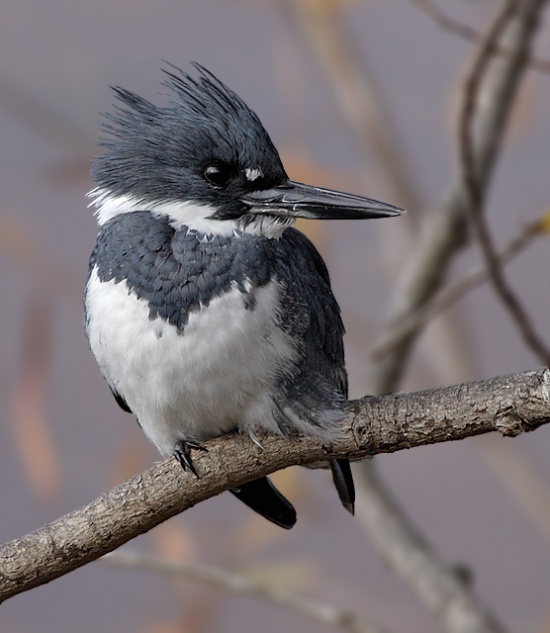
Photo © by Richard Bledsoe
Santee Lakes Regional Campground, San Diego, California, USA, 19 December 2005
- Megaceryle alcyon
Identification
28–33 cm (11-13 in)
- Big-headed and big-billed
- Larger than American Robin
- Blue-gray above
- Ragged bushy crest
- Broad gray breastband
Female
Has rufous belly band
Male
Lacks rufous belly band.
Juvenile
Has breast band rufous or mixed blue and rufous.
Distribution
Common and widespread over North America from southern Alaska east to Newfoundland (except parts of north-central Canada) and south to California and the Gulf Coast.
A partial migrant with most birds from the interior moving south in August-early November, returning in March-May, but some birds stay north in coastal areas. Winter range extends south to Mexico and Central America, the West Indies and northern South America. A common winter visitor and migrant to the Atlantic coast. Regularly recorded on Bermuda and in the Hawaiian Islands (vagrants).
Vagrants recorded in the Western Palearctic recorded in Iceland, Britain, Ireland, and the Azores, with one record for the Netherlands. There have been five Icelandic records including at least two birds in May-September 1998, a moribund female in February 2002 and a male in October 2003. British Isles records (c.10), are mostly in Ireland in October-November but there are records for all months due to long-staying individuals, one for more than a year.
Taxonomy
Most often seen as a monotypic species[1], but west coast birds are sometimes separated as caurinus. Until recently, this species was placed in genus Ceryle.
Habitat
Rivers and streams, lakes, ponds and along sea-coasts. Occurs up to 2,500m in the Rocky Mountains.
Behavior
Actions
Hovering on rapidly beating wings in readiness for the plunge, or flying with uneven wingbeats (as if changing gear), rattling as it goes, the kingfisher is easily recognized. Perches conspicuously and fishes from a perch or hovers over the water.
Breeding
Nests in burrow in dirt banks.
Voice
A harsh, woody rattle
Movements
Males often resident maintaining territories year-round. Females are a partial migrant in most of range moving south in winter to the southern USA and Central America to Panama.
References
- Clements, J. F., T. S. Schulenberg, M. J. Iliff, S. M. Billerman, T. A. Fredericks, B. L. Sullivan, and C. L. Wood. 2019. The eBird/Clements Checklist of Birds of the World: v2019. Downloaded from http://www.birds.cornell.edu/clementschecklist/download/
- Fry, C.F., Fry, K. and Harris, A. (1991). Kingfishers, Bee-eaters, and Rollers. Princeton University Press.
- Kelly, J. F., E. S. Bridge, and M. J. Hamas (2009). Belted Kingfisher (Megaceryle alcyon), version 2.0. In The Birds of North America (A. F. Poole, Editor). Cornell Lab of Ornithology, Ithaca, NY, USA. https://doi.org/10.2173/bna.84
- Woodall, P.F. (2020). Belted Kingfisher (Megaceryle alcyon). In: del Hoyo, J., Elliott, A., Sargatal, J., Christie, D.A. & de Juana, E. (eds.). Handbook of the Birds of the World Alive. Lynx Edicions, Barcelona. (retrieved from https://www.hbw.com/node/55811 on 23 February 2020).
Recommended Citation
- BirdForum Opus contributors. (2025) Belted Kingfisher. In: BirdForum, the forum for wild birds and birding. Retrieved 24 April 2025 from https://www.birdforum.net/opus/Belted_Kingfisher
External Links
Search the Gallery using the common name:
Search the Gallery using the scientific name megaceryle alcyon:
Search the Gallery using the scientific name ceryle alcyon:
GSearch checked for 2020 platform.






